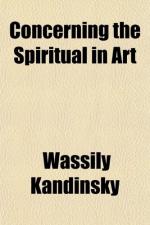The task undertaken in this Introduction is a humbler but perhaps a more necessary one. England, throughout her history, has shown scant respect for sudden spasms of theory. Whether in politics, religion, or art, she demands an historical foundation for every belief, and when such a foundation is not forthcoming she may smile indulgently, but serious interest is immediately withdrawn. I am keenly anxious that Kandinsky’s art should not suffer this fate. My personal belief in his sincerity and the future of his ideas will go for very little, but if it can be shown that he is a reasonable development of what we regard as serious art, that he is no adventurer striving for a momentary notoriety by the strangeness of his beliefs, then there is a chance that some people at least will give his art fair consideration, and that, of these people, a few will come to love it as, in my opinion, it deserves.
Post-Impressionism, that vague and much-abused term, is now almost a household word. That the name of the movement is better known than the names of its chief leaders is a sad misfortune, largely caused by the over-rapidity of its introduction into England. Within the space of two short years a mass of artists from Manet to the most recent of Cubists were thrust on a public, who had hardly realized Impressionism. The inevitable result has been complete mental chaos. The tradition of which true Post-Impressionism is the modern expression has been kept alive down the ages of European art by scattered and, until lately, neglected painters. But not since the time of the so-called Byzantines, not since the period of which Giotto and his School were the final splendid blossoming, has the “Symbolist” ideal in art held general sway over the “Naturalist.” The Primitive Italians, like their predecessors the Primitive Greeks, and, in turn, their predecessors the Egyptians, sought to express the inner feeling rather than the outer reality.
This ideal tended to be lost to sight in the naturalistic revival of the Renaissance, which derived its inspiration solely from those periods of Greek and Roman art which were pre-occupied with the expression of external reality. Although the all-embracing genius of Michelangelo kept the “Symbolist” tradition alive, it is the work of El Greco that merits the complete title of “Symbolist.” From El Greco springs Goya and the Spanish influence on Daumier and Manet. When it is remembered that, in the meantime, Rembrandt and his contemporaries, notably Brouwer, left their mark on French art in the work of Delacroix, Decamps and Courbet, the way will be seen clearly open to Cezanne and Gauguin.
The phrase “symbolist tradition” is not used to express any conscious affinity between the various generations of artists. As Kandinsky says: “the relationships in art are not necessarily ones of outward form, but are founded on inner sympathy of meaning.” Sometimes, perhaps frequently, a similarity of outward form will appear. But in tracing spiritual relationship only inner meaning must be taken into account.




